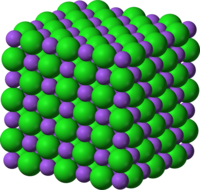
Photo from wikipedia
Abstract The thermodynamic dissipation-based approach, being one of the approved effective methods for treatment of grain growth, is refined by accounting for dissipation due to translational motion of individual grains… Click to show full abstract
Abstract The thermodynamic dissipation-based approach, being one of the approved effective methods for treatment of grain growth, is refined by accounting for dissipation due to translational motion of individual grains during grain growth. The present model introduces an interaction function correlating the velocity of translational motion and the rate of growth for individual grains. The comparison of results of simulations based on the present model with existing phase-field simulations indicates that about 1/4 to 1/3 of the driving force is dissipated by translational motion of grains lowering the grain growth kinetics and changing of the steady state grain radii distribution function.
Journal Title: Scripta Materialia
Year Published: 2018
Link to full text (if available)
Share on Social Media: Sign Up to like & get
recommendations!